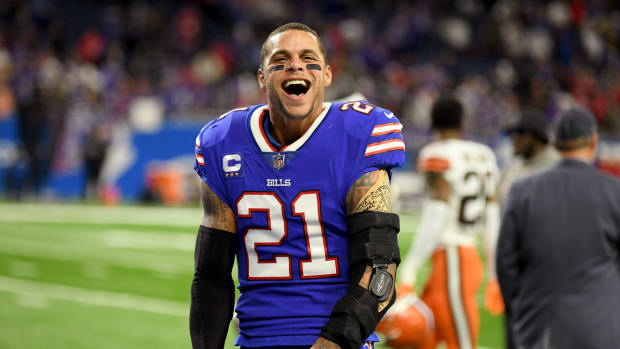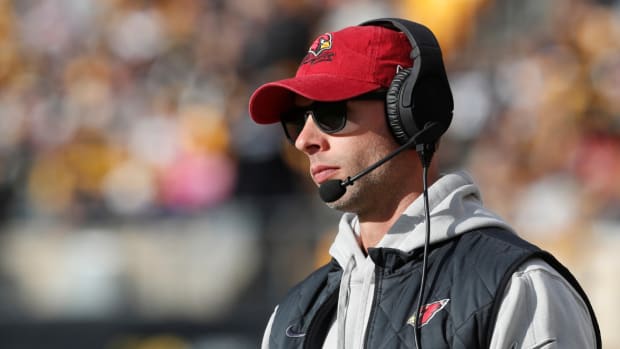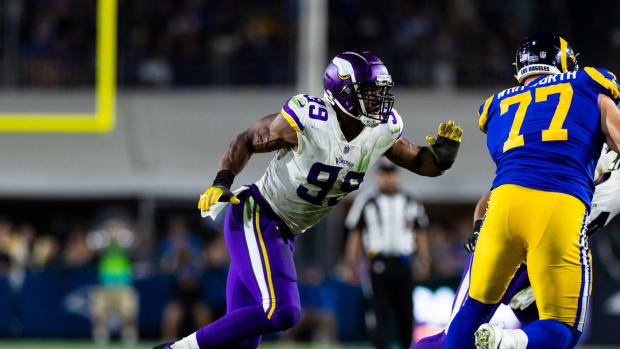David Quessenberry, Spreading Hope
This is one of a series of stories by The MMQB this season on NFL figures who have been affected by cancer.
HOUSTON — Dressed in sterile hospital gowns and medical gloves, Houston Texans offensive lineman David Quessenberry and his girlfriend, Maegan Cruse, sat on the couch across from the hospital bed where a thin boy with thinning hair sported a fat grin. Chance Boudreaux graduated high school in May, was diagnosed with large B-cell lymphoma in both legs and his chest in June, and turned 18 in his hospital bed at the MD Anderson Cancer Center in July. Soon, hopefully, he’ll get the tube that’s inserted into his arm—the conduit for his chemotherapy drug cocktail—removed for good. Then he’ll ring the bell down the hallway signaling the end of the worst part of treatment. The large man sitting across from him rang the bell off the wall when it was his turn.
“I tell you what,” Quessenberry tells Boudreaux, his mother sitting by his side, close to tears. “You get it done and your hair comes back and you can run around and not get tired. And when that thing comes out, you get to take a shower without having to wrap it up with plastic.”
Boudreaux laughs in the resigned way people do when they’re commiserating.
“I know how much it sucks,” Quessenberry says.
Says Boudreax: “I know you do.”
David Quessenberry will spend the rest of the day fighting back tears as he meets with the families of children with various types of cancer. It’s his first trip to MD Anderson as a visitor rather than a patient. On June 6, 2014, after complaining of chest pain during his second minicamp as a sixth-round pick of the Texans, Quessenberry was admitted to Houston Methodist hospital, where doctors drained two liters of blood from his lung. They thought he probably had pneumonia, but tests revealed he was suffering from non-Hodgkin T-cell lymphoma and needed to be transferred to MD Anderson, U.S. News’ No. 1-ranked cancer hospital in the U.S. His story made national news—NFL player diagnosed with potentially career-ending cancer. What did not is the the three-year fight that consumed Quessenberry and his family, and forged a deep connection between a player and an organization that supported him every step of the way.
During the first confusing days at MD Anderson in the southwest corner of the city, Quessenberry got a visit at his hospital bed from a man he’d never met. Texans owner Bob McNair, the 79-year-old billionaire team owner who came under fire this year for reportedly likening players to prison inmates during discussions of the anthem protests, came to the hospital bedside with assurances. With the diagnosis, Quessenberry had figured the Texans were through with him; roster spots are fragile enough for players chosen in the later rounds. But McNair promised the player drafted in the second-to-last round out of San Jose State a year earlier that his NFL career wasn’t over.
“Mr. McNair came by himself and he told me he’d been praying for me,” Quessenberry says, “and that I shouldn’t be scared or worried about football, that I should focus on beating this thing.”
McNair assured him the team would stand by him, and when he fought his way back to full strength, he would have a roster spot waiting. McNair told Quessenberry he knew the 23-year-old was going to beat the disease.
“It was a very compassionate thing, and that’s the kind of man he is,” Quessenberry says. “And he’s been true to it. They had my back through the whole fight. He’s a special man.”
General manager Rick Smith and coach Bill O’Brien also visited before Quessenberry returned home to Carlsbad, Ca. for the first couple months of intensive chemotherapy. For the next 10 months he’d spend five days at a time at a hospital, taking the chemo intravenously and enduring the side effects under the care of a medical staff, then 25 days at home, recovering and gearing up for the next treatment. After the first round he lay on a couch at home with his mother, Maureen, and begged her for answers she couldn’t give.
“He was like ‘Mom, why me?’” Maureen says. “And you just don’t know what to say. We just hugged each other and cried and prayed, and said we’d get through it together.”
Quessenberry struggles to articulate the specifics of his ordeal. Part of him wants to move past it, to spend a day without thinking about the endless nausea of chemotherapy, and the feelings of doubt that preceded his return to the NFL this summer. In April 2017 he was declared in remission, and the Texans, true to their word, took him back. He’s spent the season on the practice squad being a normal NFL player—that is, fighting for his job every day. But the letters from children keep coming in, and people recognize him in the supermarket as the guy who made it to the NFL, beat cancer and somehow made it back to the NFL.
“Once you’re in the cancer community, you’re in it,” he says. “Even though I beat it, I’m still meeting people all the time, doing interviews. It’s something I guess I’ll be attached to for the rest of my time.
“It was hard for me in the beginning, because it’s such a private fight, and everything was so public. Now I’ve accepted that people know my story, and hopefully I can offer some strength and motivation.”
So he retells the story in bits and pieces in a low whisper, at hospital bedsides to families searching for assurances, to acquaintances newly diagnosed, and to a reporter standing at his locker, just out of earshot of his teammates.
The beginning of the chemotherapy wasn’t so bad, but his strength slowly deteriorated, and the symptoms got worse and worse. He lost all his hair, of course, but that was an afterthought.
“People see the hair and they say, Oh that guy is going through chemo,” Maureen says. “The don’t see the constant throwing up, the headaches, the high fevers. They don’t know what happens every day.”
Says David: “Your body is weak, and you get a round of chemo and your body tries to recover, and you get another one and it doesn’t recover as much, and so on, and you get down so low you’ve got to get blood transfusions and platelet transfusions.”
In the beginning, Dr. William Wierda gave the Quessenberrys an outline of David’s treatment schedule. Ten months of intensive chemotherapy and radiation, then 30 rounds of maintenance chemotherapy. David chose to participate in a clinical trial for a drug that would put him on maintenance chemotherapy until April 2017: IV one day a month, and a daily pill. The treatment offered promise but would take longer than most plans. Armed with an assurance from McNair that he would have a chance when returned to health, and a desire to help future patients by testing out a trial drug, David agreed to the plan.
He and Maureen spent days during the first few months at home in Carlsbad in the garden. They planted olive trees and bulbs that bloom in spring. They revamped the entire backyard with a water fixture and a five-foot-tall replica of Nike of Samothrace, the statue at the Louvre commonly known as Winged Victory.
“He brought me the statue because she represents victory,” Maureen says. “We had to surround ourselves with victory. Because if you don’t, the disease will surround you and beat you.”
They charted his little victories on the treatment outline provided upon diagnosis, crossing off milestones—the day he got the tubes removed and took a celebratory dip in a pool was a big one. There were setbacks, of course. In fall of 2014 he attended the Army-Navy game in the snow in Baltimore to see his brother, a senior for the Midshipmen, and had to be admitted to the hospital afterward with a high fever.
All the while, the Texans had an open-door policy. Quessenberry would lose 70 pounds over the next year. When he felt well enough, he came to the facility to watch film and view practice. In 2015 he thought he might be allowed to rejoin the team, but the Texans told him they weren’t going to put him on the roster while he was still in treatment.
In 2016 he was an unofficial assistant offensive line coach, attending practices and meetings more often. “He was almost a coach on the sideline,” says Texans quarterback Tom Savage. “He traveled to all the away games with us. We were always talking about ball, all day, and talking about how he couldn’t wait to come back and play.”
That desire to return to normal is a constant theme in conversations with the families welcoming Quessenberry at MD Anderson three years after his diagnosis. He sits with Robert Leija and Valerie Contreras, whose 10-year-old son was diagnosed in April. The tube in his right arm had to be removed and switched to his left when he suffered an infection. Quessenberry signed a football for the family and shared a few quiet words.
“We’re big Texans fans,” says Leija, 27, “so it was awesome to meet him. Honestly I was just happy to see somebody else who went through something like this.”
There was once a widely held belief in the medical community that visits to patients with severe illnesses from survivors could have a negative effect, says Nicole Rosburg, Child Life Manager at MD Anderson. But recent studies have shown the opposite.
“I think in the past there’s been concern that having people with healthcare experiences come back into the healthcare environment poses some difficulties with boundaries and revealing personal information, and things that may not be appropriate to share,” Rosburg says. “These days that has changed, and it’s understood that really it’s beneficial, for both the people who are being visited and the survivors coming back. The survivors get the opportunity to spread hope.”
Quessenberry didn’t tell much of his story to the families at MD Anderson, in part because he knows how out of the ordinary it is. Instead, he listened, and promised what he could—how good it would feel to get that tube removed, and the triumph of ringing the bell.
“It’s hard to see kids going through that fight,” Quessenberry says. “But the kids are tough, and they’re young. It’s the parents and the families that are so helpless. At the end of the day they’re not doctors; they’re just along for the ride.”
Quessenberry believes he and his family would have been nearly overwhelmed without the network of people who came from every corner of his world to offer help. His agency, Rep1 Sports, handled the endless paperwork that came with being diagnosed with cancer as an NFL player. On days when he felt he couldn’t get out of bed, his teammates sent him reminders that his attendance was needed at the stadium. The McNair family offered a light at the end of the tunnel.
He found out how strong his family was. This spring he and his two brothers joined his mother and father in Hawaii for their 30th wedding anniversary. The occasion took on new meaning after Quessenberry finished his final of 40 rounds of chemotherapy, with his comeback season on the horizon. He looked upon the vast expanse of the Pacific Ocean and thought about all the people who got him there, and what they meant to him now.
“I don’t to like to say that cancer did anything good,” Quessenberry says. “I don’t like to give cancer that credit. It’s a terrible disease that takes the people we love too soon. If anything changed my outlook, it would be the way people came to help me and my family when we were a family that needed help. That’s a very beautiful part of the human spirit, that when someone’s in need, people come from all over to help them out.
“Cancer didn’t create that love. That love was there. It just kind of showed itself.”
Introducing SPORTS ILLUSTRATED TV, your new home for classic sports movies, award-winning documentaries, original sports programming and features. Start your seven-day free trial of SI TV now on Amazon Channels.
Question or comment? Email us at talkback@themmqb.com.






































